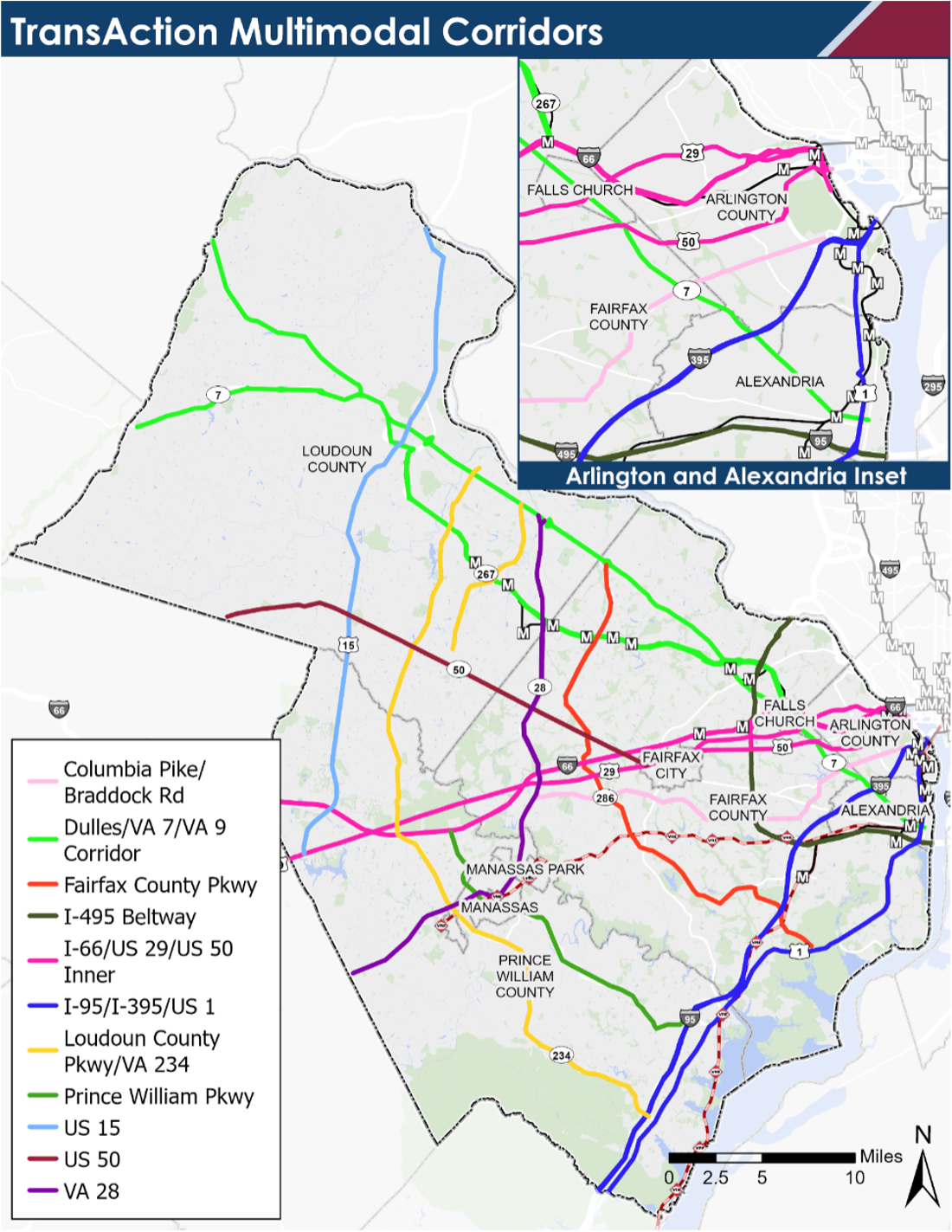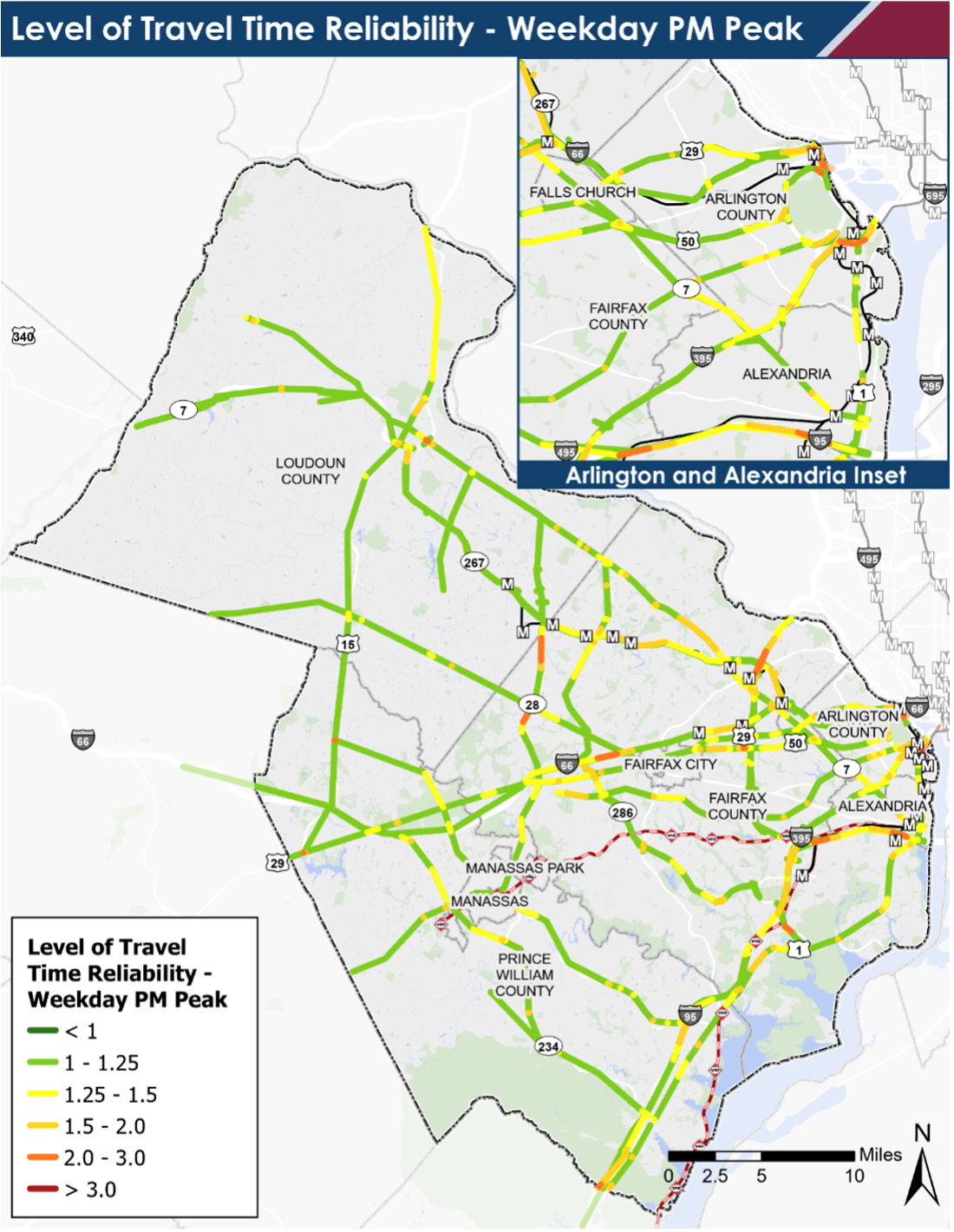Average Weekday Vehicle Miles Traveled (VMT) (2017 – 2045), in Millions
| 2017 | 2045 | % Growth | |
|---|---|---|---|
| NoVATotal | 51.6 | 65.5 | 27% |
| Arlington | 4.1 | 4.7 | 13% |
| Alexandria | 1.9 | 2.2 | 19% |
| Fairfax | 28.0 | 34.4 | 13% |
| Loudoun | 7.3 | 10.1 | 39% |
| Prince William | 10.3 | 14.2 | 38% |
Average Weekday VMT per Household (2017 – 2045)
| 2017 | 2045 | |
|---|---|---|
| NoVA Total | 58 | 55 |
| Arlington | 38 | 33 |
| Alexandria | 29 | 23 |
| Fairfax | 67 | 63 |
| Loudoun | 56 | 59 |
| Prince William | 61 | 63 |
NVTA designated 11 multimodal corridors for TransAction, shown in the map below, which are currently heavily traveled and/ or anticipated to have high travel growth. While these corridors make up about 5% of the region’s roadway mileage, they carry about 56% of regional VMT. They also include Primary Highway Freight System routes, which carry 61% of regional freight VMT.


- VA 267/VA 7/VA 9,
- I-95/I-395/US 1,
- I-495, and
- Loudoun County, VA 234
Most other corridors increase by more than 50 percent, except I-66 (32%) and Columbia Pike/Braddock Road (38%).
Segments of corridors with minimal increases (or even decreases) in delays, including I-66 from Haymarket to I-495, Fairfax County Parkway south of I-66, VA 28 north of I-66, and I-495 north of Tysons. These outcomes indicate the benefits of upcoming projects, particularly the expansion of managed lanes and transit in the I-66 corridor.
Public transit is also expected to see growth in ridership through 2045. In 2017, there were nearly 1.3 million daily transit boardings in the Washington metropolitan region, which is expected to increase to more than 1.63 million by 2045. Within Northern Virginia, total weekday boardings in 2017 were 293,000 riders across Metrorail, Metrobus, Virginia Railway Express (VRE), and local transit providers. Total daily ridership is projected to increase by 57 percent through 2045, totaling nearly 460,000 daily transit boardings. These projections and growth in ridership are shown in the figure below.
Average Weekday Transit Ridership (2017 – 2045)

Source: Northern Virginia Transportation Commission (NVTC) FY 2021 4th Quarter (April to June 2021) Ridership and Parking Report
Potential Mobility Needs and Strategies
Given the mobility performance trends presented above, including challenges presented by the continued growth in VMT, congestion and delay, as well as growing demand for transit and alternative modes, a number of transportation needs and strategies were identified in the assessment:
- More frequent and extended transit service in existing high-demand areas as well as current areas lacking service, particularly communities in equity emphasis areas;
- Address existing gaps on the regional trails system and first/last mile connections for transit riders, bicyclists, and pedestrians to activity centers and transit stations.
- Traffic management and strategic expansion to address bottlenecks and optimize capacity of high-volume travel corridors, particularly those facilitating inter-regional and cross-regional trips;
- Operational enhancements and capacity expansion on minor arterials and collector roads throughout Loudoun and Prince William counties to accommodate safe and efficient travel, plus expanded travel choices, including transit service and regional trails;
- More direct and safer connections between regional freight routes and key freight industries, distribution centers, and intermodal facilities, such as Dulles Airport; and
- Traffic management and communication systems to manage delays resulting from unpredictable events, ranging from minor crashes and breakdowns to crashes resulting in extended lane closures or the impact of severe weather events.
Coming up in this blog series, we’ll continue to explore the performance and needs in the region’s transportation system between now and 2045 through the lenses of accessibility, safety and resiliency.
